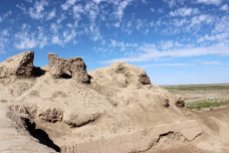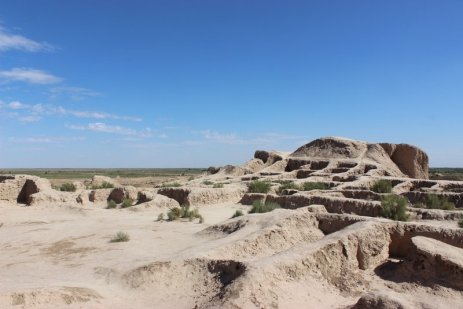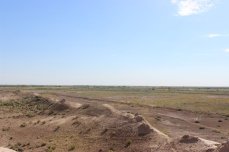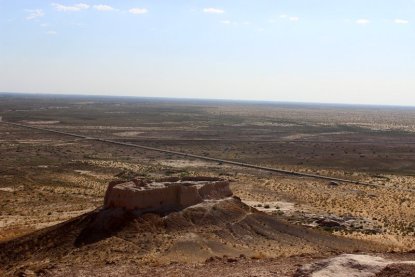Scattered across the vast Karakalpakstan region in the north-western part of Uzbekistan are the remains of many fortified settlements. These fortified settlements or qalas extend into the Khorezm Province in western Uzbekistan as well and also into the neighbouring country of Turkmenistan.
Archaeologists say that these fortified settlements were built over a 1,000-year period with the earliest fortifications making an appearance around 700 BCE. The qalas, which were constructed from compressed mud or clay bricks, were built in the fertile region created by the Amu Darya delta. It is believed that the number of qalas in the region run into hundreds; however, only about 80 or so have been documented.

I visited 2 qalas in the region — Toprak and Ayaz — and saw a third (Gyaur) from a distance, after visiting Mizdakhan and on my way to Khiva. I also made an arduous climb (my knees are still protesting after 3 months) to see the Chilpyk dakhma or Tower of Silence, but more on that later.
To travel through a vast area in a single day, see these intriguing bits of history scattered about in a desolate and barren land was quite an experience.
The first qalas were simple walled enclosures. As the centuries went by, they metamorphosed into fort complexes — from single walled fortifications to double and sometimes triple walled structures enclosing places of worship, armories, granaries, and palaces. The inhabitants of these fortified settlements were nomadic tribes, who were constantly at war with one another and with invaders from other regions. Initially, the forts were used to safeguard their most precious commodity — livestock. As agriculture began to take root in the region and the number of settlers increased, the purpose of the fortifications changed from shelter for livestock to defence outposts for farmlands.
From the fire altars, fire temples and relics discovered at the qalas, archeologists have surmised that the people who lived in the region were followers of Zoroastrianism.
The settlements fell into ruin when they were either destroyed by Arab invaders bringing in Islam or were abandoned due to the Amu Darya changing its course leaving the area literally high and dry. Nature did the rest — centuries of wind, coupled with salination from artificial irrigation-fed agriculture in recent years has ensured that there is very little left of these historic settlements.
Gyaur Kala was the first of the 3 forts I saw and the only one I didn’t actually visit. Located about a mile from the Mizdahkan necropolis, it was destroyed by the invading armies of Chengiz Khan in 1221, never to be occupied again. All that remains today are crumbling walls, which just begged to be explored. Unfortunately, I had other monuments to visit that day and was running short of time and had to regretfully leave it unexplored.

I arrived at Toprak Qala a little after noon, when the sun was directly overhead and the light harsh. In the local language, Toprak Qala means “clay fort”, a name that couldn’t be more apt. The absence of vegetation and the hard, baked clayey soil made everything look lifeless and depressing. But the remains of archaeological excavations revealed a very different story in its distant past.
Toprak Qala was first surveyed in 1940 and plans to excavate it finalised for the following year. Due to WWII, the excavation got postponed to 1945, which then continued for almost two decades. What knowledge we have about Toprak Qala comes from these excavations.
Construction of Toprak Qala commenced in the 1st or 2nd century CE. It was an imperial city and the main temple complex of the Khorezem kings who ruled the region. The qala is laid out as a lopsided rectangle, measuring about 500 m by 350 m with the four corners pointing in the cardinal directions. While the remains of the 10 m high original city wall can be seen even today, the towers, which were constructed at regular intervals along the walls and at the corners, are no longer standing. The defensive moat, which surrounded Toprak Qala, is also not visible and can only be imagined. But what can be seen are remains of the main buildings in Toprak Kala — the citadel or palace, the armoury, the fire temple, the administrative centre, etc.
Please click on any of the pictures to start the slide show on Toprak Qala and see the details and captions.
Most of the qalas in the region are on the few elevated portions of land in an otherwise flat landscape. Ayaz Qala is one such fort and has been built on top of a low hill and can be easily spotted from the distance. Though the elevation of the hill is not very high, it is steep and in the absence of a well-defined path and sandy lower slopes was a big deterrent to climbing up to the fort. But after some stern talking to myself, some effort, inhaling some fine sand, and scaring desert lizards and other creepy crawlies out of my way, I reached the top to be rewarded by some spectacular views and also an understanding of how Ayaz Qala would have functioned as a defence outpost. Click on the picture below to see a panoramic shot.
Built in the 4th century BCE, the Ayaz Qala is also rectangular in layout and measures about 180 m by 150 m. Two parallel walls, about 10 m in height surround the qala creating a vaulted corridor between them, running along the entire fort. The vaulted corridor would have provided shelter to the inhabitants as well as the soldiers who defended it. Some of the walls have collapsed, but that doesn’t take away anything from the imposing architecture. The vast space enclosed by the fort looks empty, but archaeologists have excavated wine presses and other treasures from here.
The Ayaz Qala is not just one fort, but a set of 3 forts. I climbed into one of them, saw another from the first, and missed out on seeing the third. The second Ayaz Qala, which is smaller in size and shaped like a peanut shell, was built nearly 700 years later on a hill near the first one.
When Ayaz Qala was built the area was a lush and green oasis with a lot of agricultural activity, and the fort (all 3 of them) functioned as defence outposts for them. Today, the area is known for its yurt camps and horse riding safaris that cater to the tourists.
Please click on any of the photographs below to start the slide show and read the details of the Ayaz Qala.
The Chilpyk Dakhma is perhaps the best known, not to mention the most interesting, monument in Karakalpakstan. I stumbled across it during my initial research about the area, which in turn led me to the qalas. The photographs I saw on the net were enough to make me want to pack my bags and head over immediately !
Chilpyk looks like a qala, but it is actually a dakhma or a tower or silence, where Zoroastrians dispose their dead by exposing it to the elements. Archaeologists and historians believe that the Chilpyk Dakhma was most probably the place where the members of the royal family were brought after their death. They also believe that the entire area surrounding Chilpyk may have been a sacred area for millennia.
The Chilpyk Dakhma is constructed on top of a conical hill on the banks of the Amu Darya. The view from the top of the dakhma is quite spectacular with the gently flowing river and the lush green fields it irrigates on one side, and a barren flat landscape (see first picture in this post) where the river waters do not reach on the other side. Click on the picture below to see a panoramic shot of the Amu Darya from the top of the dakhma.
The climb to the summit of the Chilpyk Dakhma is deceptively simple. There is a clear pathway leading up as you will see in the photographs below. But what the photos do not show is how steep and how sandy that pathway is. It took me nearly 40 minutes to ascend to the top, partly because I had to stop now and then to remove the sand from my shoes !
The dakhma is a circular enclosure, about 65 metres in diameter, and constructed from the same compacted clay/mud that the qalas have been made from. The walls reach up to 15 m in height and entry is through a portion of wall that appears to have caved in. Inside the dakhma, none of the internal features are visible as they are covered with layers of silt and mud. Ossuaries and relics recovered from here are at the Savitsky Museum at Nukus.
Please click on any of the photographs below to start the slide show and read the details of the Chilpyk Dakhma.
This one day’s exploration of 3 forts and a dakhma, though not exhaustive, was exhausting both physically and mentally, in more ways than one. While planning, I had underestimated the distances to be covered and also the desert heat. A lot of time was spent just travelling from one site to another. Added to this was the frustration that my guide did not know anything about the qalas and the dakhma. The most illuminating thing that she had to say was that was that these were places for young people to gather and party and celebrate birthdays ! Most of what I have written here has come from talking to Inessa, my guide at Khiva, and the little available online material that I read after the visit.
In spite of this, it was still an enjoyable day learning and experiencing a new culture and trying to understand a bygone era. The qalas are probably the oldest sites I have visited and the dakhma, even in its ruinous state, remains the only one I have seen. So in that sense the visit was special as well.
There is always something good, even in the most disappointing times. 🙂
Note: If you are visiting the region, and I sincerely hope that you do, please don’t do it the way I did it — detours made here and there from Nukus to Khiva, with a ‘guide’ from Nukus accompanying me. Instead, make Khiva your base and explore the qalas and the dakhma with a guide from there. Spend an extra day if you have to at Khiva, but don’t do it the way I did it.
My Dream Trip Uzbekistan Series:
Dear Uzbekistan | A city called Nukus | Art in the Desert: The Savitsky Collection at Nukus | Mizdahkan: A city for the dead | 3 forts and a dakhma | Itchan Kala of Khiva | There’s something about Bukhara! | Monumental Bukhara | The Jewish Heritage of Bukhara | Shakhrisabz: The home town of Amir Timur | The Registan Square of Samarqand | The blue city of Samarqand | The surprise & delight that was Tashkent | Uzbekistan: The food & markets special |The Uzbekistan trip planner |
Join me on Twitter, Facebook and Instagram as I share this journey and all “My Favourite Things” with you.




































If you want to see an actual man-made (constructed) dakhma do head to Diu where you can actually walk into an otherwise totally prohibited place even for the Zoroastrian priests where only the four khandias or pall bearers are allowed to take the body in the dakhma. The earlier natural dakhmas are there in Iran as well.
LikeLiked by 1 person
Thanks for the info on the Diu Dakhma, Aadil. I’m not sure I want to go to a real, ‘live’ Dakhma. But wil keep what you said in mind whenever I visit the places you have mentioned.
LikeLiked by 1 person
Superlative!
LikeLiked by 1 person
Thank you for the appreciation, Lata. 🙂
LikeLiked by 1 person
superb clicks!
LikeLiked by 1 person
Thank you, Archana. Hope you had a look at the other pictures and posts in the Uzbekistan series. 🙂
LikeLike
The forts look so deserted. Beautiful photos, loved the first one especially – scattered clourds, a small hill in the distance and not a single soul in the vicinity.
LikeLiked by 1 person
Uzbekistan is not very populated and the only crowds that one sees are at monuments and that too, other tourists.
Distances are vast and I still remember the 7 hour road journey from Khiva to Bukhara, where I must have passed some 10-15 cars and some 20-25 people. That’s all !
LikeLike
Nice blog post and pics too. The way you describe your whole journey though pictures are really superb. I downloaded your some incredible pics too.
I also love to write, as I am native to Alwar city, Rajasthan. So generally I write about places to visit in Alwar. You can also check my blogs at- https://goo.gl/kW0KMU , http://goo.gl/vo0N1p
I am waiting for that day when you’ll come at my place to describe it in your blog.
LikeLike
The Hadoti region is one area in Rajasthan that I haven’t visited. Hopefully, I’ll be able to remedy that at the earliest by visiting Alwar and other nearby places.
LikeLike
Alwar is waiting for you mam. Visit Alwar and describe this place in your words via incredible images of my city.
LikeLike
Lovely pictures and a fantastic description of the qualas and the dakhma. It is amazing how these old beautiful structures yet exist and the newer constructions like those in our cities crumble or come apart within twenty to thirty years.
LikeLike
Thank you, Neena. So happy you liked the post. I guess old things were built to last and newer ones are built to be replaced every few yaers. Technologies change, aesthetics change, design sensibilities change, so it is only natural that structures change as well.
LikeLike
What a beautiful travel experience. How I’d you chance upon something so interesting….
LikeLike
Yes, this was a beautiful travel experience as was the entire Uzbekistan trip. Some research and also asking around brought these places into my itinerary.
LikeLike